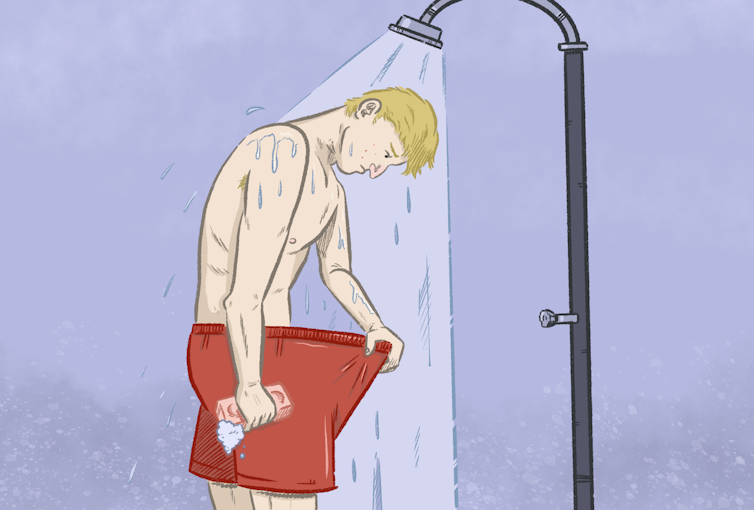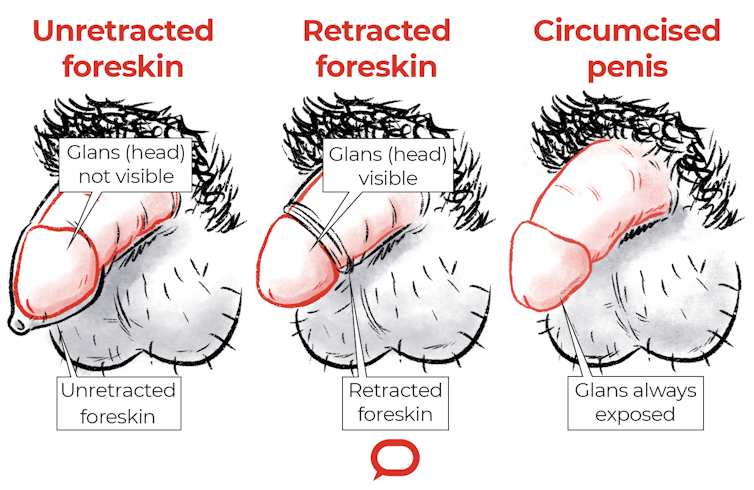
David King, The University of Queensland
Growing up, no one ever gave me the rundown on how or what I should do to keep my penis clean […] I’ve never read any reliable answer beyond washing it with water. Do I use soap? Any soap? How normal is smegma? If my penis gets itchy from smegma should I go see a doctor? If so, my GP or a urologist? — Anonymous
Key points
- clean under the foreskin, using soap, but not too much
- smegma is normal
- if you have any concerns, see your GP.
It’s a shame some people think talking about cleaning and caring for our genitals is embarrassing or taboo. We probably know more about hair care than penis care.
The penis is simply another part of our anatomy, so cleaning should be relatively straight forward.
If you’ve been circumcised, where your foreskin was removed soon after birth, your penis will look something like the one in the diagram (below, right), with the head (or glans) always exposed.
But if you have a foreskin (below left and centre), there are some extra things to think about when washing, which we’ll get to soon.

Foreskin facts
But first, some foreskin facts. From around the time you turn five, your foreskin separates from the head of your penis, bit by bit. This allows you to pull back your foreskin (retract it). In some boys, the foreskin can stay partially stuck to the head of the penis until puberty.
You should never forcibly pull back your foreskin. That’ll be painful, you could bleed, you could scar, or have other complications.
OK, now for the washing part
Once your foreskin separates easily from the glans, gently retract and clean underneath the foreskin with each bath or shower. Then, after washing, pull the foreskin forward to its normal position.
When it’s time to dry off, retract the foreskin again so you can dry the head of the penis with a towel. Then, you guessed it, pull the foreskin forward to its normal position.
It’s OK to clean with soap whether you have a foreskin or not. But generally, too much soap is worse than none at all. Excessive cleaning removes essential body oils that would normally keep our skin moist and reduce friction. If you have sensitive skin, you can use a soap-free wash from the chemist.
What about smegma?
Smegma is a thick, whitish discharge consisting of a build-up of dead skin cells, oil and other fluids under the foreskin. And it’s very useful. It protects and lubricates the penis.
Some people have oilier skin than others and tend to have more smegma. So some smegma is normal, but if you have too much or it becomes smelly, you may need to clean more.
Things to watch out for (and when to see your GP)
If the head of your penis becomes painful, red, itchy and has a discharge, you may have a treatable condition called balanitis.
It’s more common if you have a foreskin. And the bacteria and fungus that cause it like the warm and moist conditions under there.
Skin disorders, infection, poor hygiene, friction from sexual activity, and using too much soap all cause the condition.
Read more: How to make your next sexual health check less, erm ... awkward
You can clear a mild case with good hygiene and simple treatments, such as an antiseptic or antifungal cream. You can buy these from any pharmacy. In addition to the medication, the cream itself helps protect and moisturise the inflammed skin.
If you have balanitis you may need to be more careful than usual to avoid urine irritating your inflamed skin. Retract your foreskin when you urinate. Dry the head of the penis gently after you finish.
If your penis is still inflamed after a week of these simple measures it’s best to see your GP. They can then investigate other causes, such as psoriasis or an allergy.
I Need to Know is our series for teens in search of reliable, confidential advice about life’s tricky questions. Here are some questions we’ve already answered.![]()
David King, Senior Lecturer, The University of Queensland
This article is republished from The Conversation under a Creative Commons license. Read the original article.




